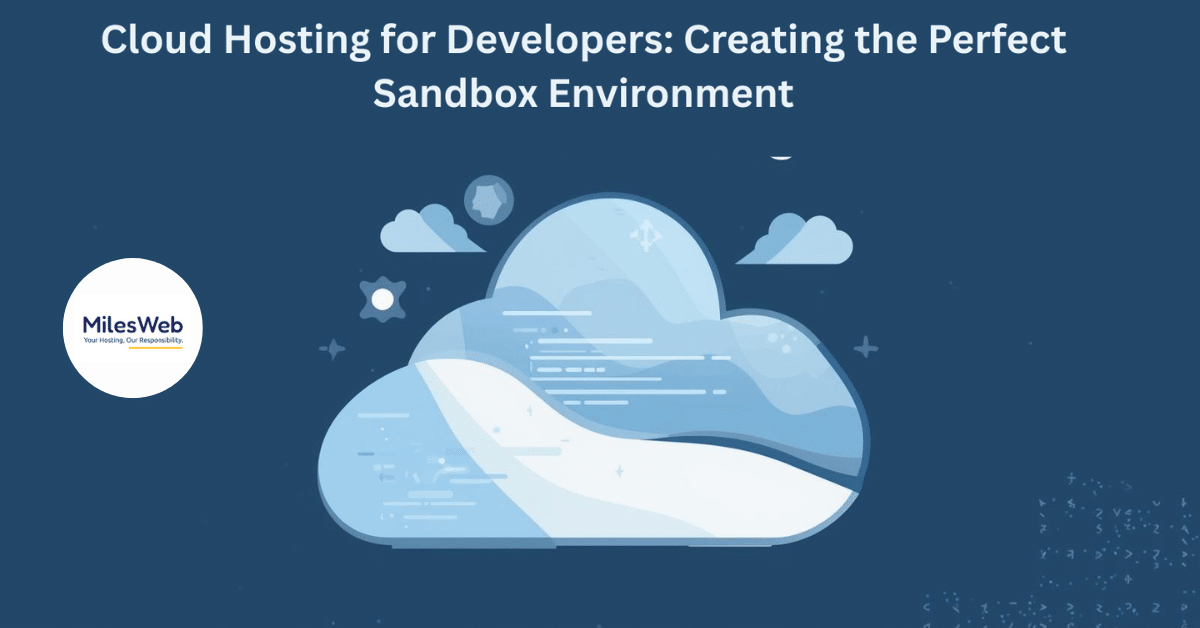Cloud Hosting for Developers: Creating the Perfect Sandbox Environment
To continue innovating, developers need an environment where they can fail safely and work in production. This is where cloud hosting services can help. Cloud VPS India allows developers to have a ‘sandbox’ where they can prototype and test code and frameworks safely and efficiently.
In this article, we look at how cloud hosting enables developers to create sophisticated sandbox environments. We analyze the benefits of easy cloud server cost per month in such environments and how they create value for contemporary development processes.
What is a Sandbox Environment?
A sandbox environment is a dedicated and isolated space within a cloud hosting provider where developers can run and test applications as well as perform experiments freely without affecting any of the live systems. It is a ‘safe’ environment where any developer can play without fear of breaking things permanently, and it allows for bug fixing and integration testing before deployment.
In the past, sandboxes were costly, as they needed to be housed within the company’s infrastructure. With the evolution of cloud hosting, developers now can rapidly create and scale sandboxes that are production-level derived at an affordable rate. This comes with the added benefit of no in-house server management.
Why Cloud Hosting is Ideal for Sandboxes
Considering all the elements that require compliance, cloud hosting has emerged as the best option when it comes to sandboxes. Here is a brief overview:
1. Measured Scalability
Different phases of the Sandbox project may require different levels of resource allocation, which is why it is important to be able to instantly scale Computer processing units (CPUs), random access memory (RAM), and storage elements. Overpayment can be avoided when trying to project resources to match the project needs.
2. Better Price Points
Contrary to conventional hosting, cloud hosting takes servicing to a new level in that it allows developers to only pay for the resources utilized. The budget is better managed, as the temporary sandbox environments can be created, tested, and destroyed.
3. Enhanced Security
Production environments and sandboxes are best isolated from each other. Failure of an experiment does not lead to compromise on the production system, and bugs do not cause damage.
4. Improved Teamwork
Cloud sandboxes are a solution to ease access for teams in different locations. They can share the sandboxes as they work on them. A whole team can work on integrations, coding, and system assessments simultaneously.
5. Reduced Time
The time taken to set up a cloud sandbox can be decreased to a couple of minutes with the use of automation tools and other preconfigured templates available with cloud service providers.
Building the Perfect Sandbox in the Cloud
Overall, it takes a couple of days to set up a cloud sandbox in its entirety. Now the question is, how can a developer utilize the powerful features of a cloud hosting service for creating a sandbox?
1. Select an Appropriate Cloud Provider
It all begins with the right provider. Consider the following:
– Vertically integrated pricing models
– Developer infrastructure with minus touch APIs/SDKs and other extensible platforms
– Scalability
– Security
Solutions offered by developer-focused providers give the flexibility and tools to construct an adequate developer sandbox.
2. Production Environment Mirror
To take full advantage of testing, it is paramount for the sandbox to mimic production as closely as it can. Consider:
– Database systems/Network/Operating systems/Application frameworks
This solves the “works on my machine” dilemma while providing for easy deployments.
3. Automate using Virtual Machines and Containers
Docker and Kubernetes, in particular, have transformed sandbox production. Containers allow developers to rapidly provision and manage lightweight environments. Virtual Machines provide an additional layer of isolation.
4. Implementing Continuous Integration and Continuous Deployment (CI/CD)
Placing CI/CD pipelines in sandboxed environments ensures all changes to the code are tested automatically before production to safeguard the code. This improves the overall development lifecycle.
5. Optimize and Monitor
Mistakes, resource usage, and overall performance can be tracked with certain tools even in the sandbox environments. This remains crucial for testing and maintaining optimal performance and also provides insights for improving applications before release.
Benefits for Developers
The creation of cloud-based sandbox environments has numerous advantages for developers.
- No-Worries Innovation: Developers can pursue new ideas regardless of the consequences they may have on production.
- Rapid Development Cycle: Concepts can be turned into prototypes seamlessly and developed quickly.
- Streamlined Teamwork: Developers working from remote locations can have a single point of access to the same sandbox.
- Data Protection: Testing sensitive information on the cloud is an example of cloud sandbox environments.
- Resource Efficiency: Developers do not pay for resources that they do not use.
Examples of Cloud Sandboxes
Cloud sandboxes can be considered practical examples, and they have multiple applications across multiple industries.
- API and Integration Testing: Developers can ensure that third-party applications are integrated properly before going live.
- Feature Prototyping: New features can be tested within a controlled environment to ensure they function correctly.
- Training Platform: Developers who are new to the working environment can use sandboxes to practice their skills.
- Performance Testing: Cloud environments allow the curtailing of resources to simulate sudden spikes in traffic.
Closing Perspective
With the advantages of sandboxing, cloud hosting has changed the approaches of many developers. The cloud’s scalability, security, measured cost, and flexibility meet the blockade head-on and keep the developers engaged in new innovations rather than outdated practices.
The ideal sandbox should be a replica of the production environment and should incorporate cutting-edge technologies such as containers and CI/CD pipelines, which are all hosted on the cloud.
Developers will be working, paving the path for smarter, safer, and trustworthy scalable applications, as the demand for rapid software application development and innovation surges. The developers who are the most efficient will harness the cloud’s geo-replicated sandboxes far away.

